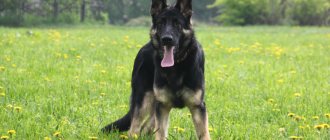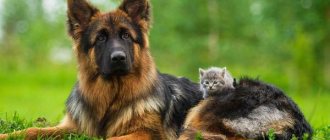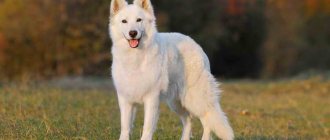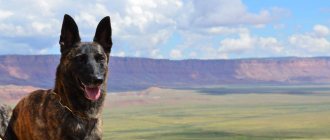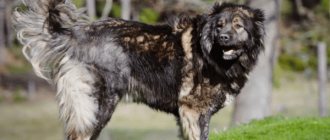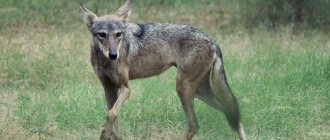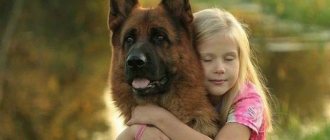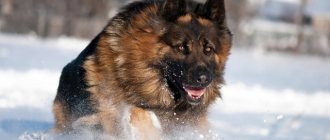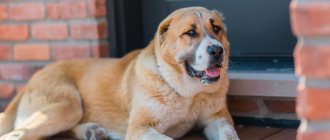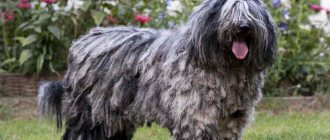Story
If you look at the map, you can see the Shetland Islands in the northeast of Scotland. In ancient times, the aboriginal, extinct "Yakki" dogs lived there. Most likely, they formed the basis of the Sheltie breed. According to experts, the Norwegian Buhund and the short Laika from Greenland also participated in its appearance.
Unfortunately, not a single documentary evidence of the true origin of the Sheltie has survived . It is possible that she is as old as the world, and her original name sounded like “dog tuni” (translated from the ancient Gaelic language as “farm dog”).
The small and agile ancestors of the Sheltie herded small sheep, which practically do not exist in our time. The islands of their habitat were protected by a water boundary from predatory animals, and therefore there was no need to protect flocks of sheep from wolves.
Since that time, a lot has changed, the sheep became larger and larger and more vicious dogs were needed to herd and guard them. The need for a miniature Sheltie disappeared by itself and as a result, she could completely disappear from the face of the earth.
Fortunately, Sheltie quickly found herself in a different role. She became a companion dog and human companion. The breed was stabilized and improved by infusing it with the blood of the Scottish Shepherd Collie, brought to the Shetland Islands from Great Britain.
During her formative years, the cutie Sheltie underwent many “design” decisions. They tried to breed her with Spitz and Papillon, and they mixed her with Border Collie and King Charles Spaniel genes. Until the beginning of the 20th century, her family tree was in complete disarray.
In 1914, thanks to breed lovers, an active struggle began to restore the purebred Sheltie line, which lasted until 1947. The fundamental breed standard was adopted in 1948, and further adjustments were made to it in 1987. In this form, the unique Sheltie has survived to this day.
Origin
Sheltie is a fairly well-known breed in the Russian Federation. Externally, Sheltie is very similar to another breed of dog, a collie, reduced in size. It is believed that the ancestors of modern Shelties originated from herding dogs from the Shetland Islands (in the north-eastern part of Scotland). There are many versions about how old the Sheltie breed is, but adequate historical sources about its antiquity cannot be found. It is known for certain that in the 19th century, during the consolidation of sheep farms, Fr. Shetland, small shepherds could no longer cope with the growing number of sheep, and were replaced by other, larger dogs (Collie, etc.) At the same time, they tried to “enlarge” and “standardize” Shelties using selection tricks - crossings with other breeds. However, at the beginning of the 20th century, groups of enthusiasts created several breed clubs and in 1914 fixed the first characteristics of the breed standard. This is how the Sheltie was saved, and this dog gradually acquired its modern characteristics.
Description and standard
Characteristic
The Sheltie is primarily a working and herding breed of dog, and secondly, it is a wonderful friend and companion for humans. In her they found a combination of intelligence, strength, energy, harmony, grace and beauty. The proud posture, luxurious fur and purposeful look of this baby cannot leave viewers indifferent.
The breed has a symmetrical silhouette and correct proportions of all parts of the body. An alert and intelligent, noble dog with a pretty expression on its face - this is all Sheltie in person.
Weight can range from 6.4 to 12 kg. There is a slight discrepancy in the size of an adult dog. Height at the withers is from 35.5 to 37 cm. Males are usually larger than females.
It is also necessary to say how long representatives of this breed live. The lifespan of dogs depends on the conditions of keeping and care, on average it is 12 -15 years.
RKF standards
- Dry body type.
- The case is harmoniously built, small in size, and has a slightly stretched format.
- The skeleton is strong, without pronounced power.
- The skin is elastic, fits tightly, has no wrinkles or folds.
- The head is set proudly, neat and sophisticated. The width of the head is proportional to its length and looks harmonious in relation to the size of the animal. The forehead is flat, the occipital part is pronounced, the transition to the muzzle is moderate.
- The skull has the shape of a blunt wedge, tapering in the area of the nose.
- The nose has a long bridge, the bridge of the nose is straight, the nose is black.
- The lips are dry, tightly adjacent to each other.
- Teeth set vertically, scissor bite, set of teeth 42.
- The jaws are developed, the cheekbones have strong chewing muscles.
- The eyes are not large, an almond-shaped cut is required. Pupils of all shades of brown. Blue-eyed Shelties must be blue in color.
- The ears are small and set high. ¾ of the ear is in a standing position, and its tips are hanging and directed forward. If the ears do not stand up as expected, they can be raised.
- The neck is curved, beautiful, of medium length.
- The withers are weakly expressed. The chest is deep and spacious, narrowing below.
- The belly is pulled towards the body, the groin line is hidden by hair.
- The back is flat, the lumbar region is slightly raised, the croup is sloping.
- The shoulders and shoulder blades are articulated at right angles.
- The limbs are smooth, set straight, moderately strong. The hind limbs have stronger muscles than the forelimbs.
- The hock joints are vertical and strong.
- The paws are round in shape, the paw pads are compressed tightly, the claws are strong and black.
- The tail is set low, pointing downwards when carried down and reaching the hocks. When moving, the Sheltie's tail is raised, but not thrown over its back.
- The crescent shape of the tail is conditionally acceptable.
- Movements are graceful, flexible and flexible. The run is fast, giving the impression of flight. The push jump is strong. Ambling and crossing movements are not typical for the breed.
Breed standard
The Shetland Sheepdog has a harmonious physique. Despite her small height ( 34-40 cm ) and low weight ( 6.4-12 kg ), the Sheltie is strong, energetic, agile and hardworking. This breed cannot be called a dwarf, because among its ancestors there are large dogs, for example, collies. Deviations in height of more than 2.5 cm are not allowed. With such a defect, the Sheltie will not be recognized as a purebred, it will be considered a mixed breed.
A graceful, refined, wedge-shaped head rests on a not too long, strong neck. The skull is flat. The ears are ¾ erect and small in size; looking at the dog, you get the impression that they are constantly moving. Fully erect ears are considered a defect. The dark eyes are almond-shaped, not large, and set obliquely. The look is intelligent, studying. The nose is black, the jaws are strong, the teeth are large, and the bite is scissor-shaped.
The body is elongated, the loin is convex, short, the back is straight. High-buttness is unacceptable. The stomach is slightly tucked. The chest is deep, the ribs are convex, but do not interfere with free, fast movements. The legs are straight, with well-developed muscles, wide hips. The paws are oval-shaped with hard, thick pads and strong nails. Sheltie moves at a trot. The length of the tail reaches the hock joint.
The coat is long and straight. There is a thick undercoat. There is a lush mane on the neck and withers. The following colors are allowed:
1. Tricolor. 2. Sable. 3. Blue Merle. 4. Black with white spots. 5. Black and tan.
Coat and colors
Wool is the main decoration for a Sheltie dog. Her luxurious fur coat has a rich and dense undercoat. It supports the long and heavy spine in an almost vertical position.
A recognizable feature of the Sheltie breed is a voluminous “lion’s mane” and a lush collar area. The outer hair on the body is coarse and as straight as possible. The riding breeches and tail area have the longest hair and elegant fringes. The hair on the face and paws is short and dense.
Acceptable colors
- Tricolor (black and tan with white markings);
- Sable (a combination of red, red, gold and white);
- Two-color (black and white);
- B-merle (white with silver flecks and black stripes);
- Blue Merle (silver-blue color and black specks);
- Marble.
Sheltie's vices
- liquid and soft wool;
- thinness;
- obesity;
- Round eyes;
- hanging or erect ears;
- short and blunt muzzle;
- malocclusion;
- ring tail;
- short and disproportionate legs.
Health
Like any other breed of dog, Sheltie is prone to certain diseases:
- dysplasia of the hip and elbow joints,
- hypothyroidism,
- eye diseases,
- epilepsy.
Preventive measures to protect your Sheltie puppy
- To keep your Sheltie puppy completely safe, you first need to minimize his contact with unfamiliar dogs, especially strays. Therefore, you should not let your dog off the leash, as in this case it will become impossible to control its behavior and communication with other dogs. Since a dog can easily become infected with distemper from simply touching the nose of a sick animal. This disease can be transmitted to a dog through sniffing. Your dog can become infected with trichophytosis from contact with the lichen-affected fur of a sick dog. Naturally, it is impossible to completely exclude a dog’s communication with other dogs, since it must be socialized. Therefore, try to find friends with dog lovers who look after their animals. By adhering to this rule, you can eliminate the risk of pathogen transmission by 80%.
- You should walk your dog in places where there are no landfills. Since garbage very often attracts rodents, which in turn are very often carriers of various infections. Gray rats are especially dangerous because they carry such a serious disease as leptospirosis.
- You should not allow your dog to sniff other people's feces, as they are a source of worms.
- Monitor your Sheltie's well-being. Pay attention to even the most minor changes in his behavior. For example, your dog may appear lethargic, lose his appetite, or have a dry nose. Or you may notice that the dog begins to shed, and this has nothing to do with seasonal shedding. If hair loss becomes excessive, this is the first symptom indicating health problems in your pet. And only you can help him. Therefore, it is important to take the dog to the veterinary clinic in time, where the disease can be overcome for sure. In no case should you ignore the symptoms, since advanced infections are much more difficult to treat, and sometimes even impossible. If you start treating your dog, the disease can lead to his death or he will develop serious complications that will affect his hearing, vision, limbs and much more.
Collie and Sheltie - similarities and differences
As mentioned above, the older Collie brothers participated in the improvement of the Sheltie, but calling the Sheltie a “mini Collie” or its “clone” is fundamentally correct. Undoubtedly, both breeds are similar in their high intelligence, muzzle shape, colors and coat, and this cannot be denied. When examined in detail, they have actual differences.
Difference table
| Comparative parameters | Sheltie | Collie |
| FCI standard | № 88 | № 156 |
| Maximum height at withers | 37 cm | 61 cm |
| Activity | Moderate | Strong |
| Security qualities | None | Average |
| Health and immunity | Weak | Good |
Sheltie and Collie are related, but not the same breeds. They have visual similarities, but their ancestors were dogs living in different territories in different time periods.
A distinctive feature for collies and shelties is that when trotting, they keep their heads slightly down, and not upright, like most dogs.
And one more important factor. If among the Scottish Sheepdogs Collie there is a variety of Border Collie, that is, short-haired, then among the Shelties such a variety does not exist.
If someone convinces you that the puppy is a rare breed of mini Sheltie, then most likely this is a scammer who is trying to sell you a wonderful mongrel, but for a large sum of money.
Tendency to diseases
- Pelvic dysplasia.
- Hypothyroidism.
- Epilepsy.
- Skin problems.
- Deafness from birth.
- Von Willebrand's disease.
- Congenital dislocations.
- Eye diseases.
Joint problems are the scourge of the breed. Dislocations and accelerated wear lead to lameness and pain. Chronic and congenital damage can only be corrected by surgery. Genetics influences the likelihood of chronic problems that worsen with age.
Sheltie skin problems should also be treated with increased attention: an untreated disease with peeling, redness or hair loss can lead to oncology.
Retinal detachment and visual impairment are a problem in 90% of the American Collie line. For some, this will result in mild visual impairment, while other dogs may go blind. The disease has no cure.
Temperament and character
The Sheltie is distinguished by its loyal character, easy-going disposition, playful and stable temperament . She is full of positive energy, moderately vigilant and careful. Sheltie is infinitely affectionate and gentle with members of the household, but with strangers she is distrustful and prefers to keep her distance from them.
Any manifestation of aggression on the part of the Sheltie towards anyone is a defect of the breed!
Sheltie is an eternal puppy, she is ready to tirelessly play and frolic in the fresh air. As an adult, she will become an excellent nanny for babies. The breed knows how to get along under one roof and gets along with cats, birds, rodents, and other dogs and will never offend anyone. It is not typical for her to dominate in a pack of her own kind, and she usually takes the role of a follower.
The Sheltie breed is not vindictive or jealous, but very boring in its essence. In the absence of the owner, she is capable of panic, and his loss for a long period of time will become real torture for her. She can really refuse food and become depressed.
When deciding to buy a Sheltie puppy, think in advance about whether you can spend enough time with your friend.
Character
Sheltie loves to be the center of attention, she likes to live in families with many household members. This is a devoted and affectionate friend, ready to play, run, and jump all day long. It seems that the Shetland Sheepdog never runs out of energy. Loneliness is destructive for such a dog; it requires the attention of its owner. She always strives to please him, expecting praise in return.
The Sheltie's good nature allows them to be children's best friends. Kids love to play with small and cheerful dogs that will never cause harm and can protect. The dog always greets strangers with a loud bark, notifying the owner. He behaves extremely warily with strangers, constantly watching their actions.
It is friendly towards other domestic animals, no matter whether it is a calf or a kitten, but at the same time strives to dominate everyone and gather everyone in one place. The main thing is not to encourage the shepherd instinct, not to allow the dog to play chase with either animals or vehicles.
Beautiful photos and pictures
Education and training
Raising a Sheltie puppy should be done from the first day it arrives in the house. Already at 2 months of age they understand what can and cannot be done. They extremely rarely damage shoes and furniture, so as not to upset their owner once again, and they quickly learn to go to the toilet outside.
The need for daily walks for the breed is 30-40 minutes 2 times a day. They need physical exercise and regular jogging like air. The Sheltie should release energy outside, rather than splashing it out at home.
Bringing joy to a person is the main purpose and goal of every Sheltie’s life. Dogs of this breed love to learn, are distinguished by good obedience, exemplary behavior and tractability.
However, they are timid in front of the outside world. They are frightened by sharp sounds and noise from cars. Therefore, they require early socialization and adaptation. The Sheltie is characterized by a “painful” reaction to the trainer’s raised voice, and even more so to physical punishment.
Never punish or yell at a Sheltie under any circumstances. Raise and train your dog calmly and patiently, finding a common language with him.
The best training method is through play. By directing the Sheltie's energy in the right direction, luring her with a tasty morsel or toy, and sometimes with your own example, you can get a highly organized and obedient dog.
Small, nimble and agile, the Sheltie shows excellent results in agility. She can easily perform any circus tricks.
Care
The dog needs to be washed once a month. Shelties themselves take care of their fur by licking themselves, so you shouldn’t take baths more often - you can dry out the skin.
Particular attention is paid to the safety of the ears: water should not get into them.
To dry, you should use a towel, stroking the animal's fur with it. Do not rub too hard - this can negatively affect the condition of the undercoat.
You need to brush your dog weekly. Breeders do this every day, and during shedding, twice a day. Particular attention to the ears. Hair often falls behind them, interfering with proper positioning. In hot weather or in southern climates, the Sheltie needs to be bathed and brushed more often.
The specific smell of “dog” can only be present in a seriously wet dog; it is not present in its natural state.
The need for mental and physical exercise dictates walking in company - with people and animals. The pet allows the instinct of a shepherd dog to unfold - it “grazes” the whole company. Experts advise setting a minimum walking period of three hours a day.
In puppyhood, walks should be limited to half an hour, but the number of walks should be at least three. In winter, time spent outside should be cut back. Avoid icy paths - the puppy spreads its paws wider and slides. The result is incorrect placement of the limbs.
During walks, you should not allow your baby to crawl under low surfaces: when trying to climb out, dislocations and sprains are possible.
If the dog is “apartment”, in the first months of life you will have to carry it in your arms to avoid stairs. Overcoming such obstacles on your own can lead to incorrect placement of the croup.
It is not recommended to pet small puppies on the head - this harmless process can interfere with the development of ears.
Animal protein is the basis of the Shetland Sheepdog diet. Even babies who have reached the age of two months are recommended to feed meat “scraper” - frozen and finely grated meat.
We advise you to read: South African Boerboel Dog Breed
In general, it is better for Sheltie puppies to puree their natural food and pass it through a meat grinder: sea fish, vegetables, cheeses.
Shelties love berries, so garden raspberries or strawberries will be an excellent treat. And greens will supply the body with vitamins.
Foods that should not be included in the Sheltie diet:
- Sweet and flour products.
- Tubular bones.
- Pasta and wheat bread.
- Potato.
- Legume plant.
- Spices, smoked foods, saltiness.
Mental abilities and intelligence
Sheltie can be safely called a super-intellectual. It is among the top 10 smartest dog breeds on the planet and takes a respectable 5th place (there are about 400 dog breeds in the world). This fact confirms that the Sheltie has the development of the mind of a 5-6 year old child.
By about 4 months of age, Sheltie puppies exhibit extraordinary mental abilities. They need to be stimulated, supported and developed. If proper attention is paid to education and training, then at the age of 1 year the Sheltie can remember a large number of commands.
With consistent training, a Sheltie can remember and understand about 1,000 human words!
Maintenance and care
Sheltie - suitable exclusively for home keeping. Considering her small size, she will be an excellent dog in a city apartment. There is no doubt that suburban housing would be an ideal option for her. Fresh air and free walking in the garden will have a beneficial effect on the dog's health.
A well-groomed Sheltie brings admiring glances from passers-by and pride to the owner . The standard set of care procedures includes the following items:
Wool
The Sheltie's long coat will require important care. Its natural feature is that it almost never gets into tangles, except behind the ears, where the hair has a softer structure. It is enough to comb the dog 1-2 times a week with a comb with long and rotating teeth.
Shedding
A dog in a city apartment can shed all year round due to dry air or due to lack of nutrients. Ideally, Sheltie sheds twice a year, in spring and autumn, and lasts about 3 weeks. At this time, it is important to help the dog change its coat faster. To remove dead undercoat efficiently, you will need a furminator.
Eyes
No daily eye care is required. It is enough to inspect them regularly and wipe them with zoo lotions as necessary. The Sheltie's eyes should be clean and free of purulent discharge. It is prohibited to instill medications into the eyes without a doctor’s advice.
Ears
The Sheltie's ears need to be cleaned of wax and dirt once a week with a cotton swab, but not with a cotton swab. For these purposes, special lotions are used that help to quickly cope with the task.
Bathing
Bathing with Sheltie shampoo is carried out as soon as the dog gets dirty or after shedding and complete combing. The detergent is selected according to the type of long coat; human shampoos are not used. It is also not recommended to use tar and laundry soap. The Sheltie's coat dries in at least 6 hours after bathing. It is not advisable to dry it with a hairdryer; hot air will make the Sheltie’s coat dull.
Claws
If a dog does not grind its claws down on its own during walks, then it needs to trim them so as not to damage the blood vessels (only the curved tip is cut off). Paws. After a walk, the paws are washed and examined for wounds, cracks, splinters and cuts. In winter, Sheltie's paws can be lubricated with baby cream or Vaseline, protecting them from reagents.
Teeth
Mouth hygiene for a Sheltie dog is very important. Tartar and plaque are harmful to teeth; to clean them, you can use special pastes or visit a veterinarian for professional care. First of all, the presence of dental diseases, such as caries, stomatitis and gum disease, is influenced by the animal’s diet.
If the Sheltie does not go to shows, then his coat can be trimmed in the groin area, ears and on the paw pads. This breed is not given a thorough haircut! Among other things, do not forget about regular and preventive vaccination and treatment of your dog against blood-sucking insects, especially in the spring and autumn.
Description of the breed
Many people choose a pet based on the description of the breed and the character of the Sheltie. The animals have long hair with a silky effect, a pointed muzzle, and a piercing gaze. These qualities were inherited from the long-haired collies with which they were actively mated.
The small size of the dog allows it to easily adapt to any environment. The fact is that the Sheltie’s ancestors lived in an archipelago with harsh weather conditions; in ancient times they never ate enough, so they did not gain or grow weight.
The breed gained popularity around the world in the twentieth century, but it was bred in country houses. This is due to the pet’s willingness to run and jump freely for several hours in a row.
Main characteristics
The description of the Sheltie dog indicates that they are small animals, since their body weight is five or ten kilograms. If the weight is exceeded by several kilos, then representatives of the breeding commissions do not consider this a problem. They are more demanding about the growth of a purebred animal:
- the male must grow to 37 centimeters;
- female – up to 35.5 centimeters.
If the height is less or more than two and a half centimeters, then the Sheltie automatically falls out of the breed and cannot participate in exhibitions. A purebred individual has a soft coat, a thick undercoat, a mane and long trousers on the legs. A special feature of the Sheltie is the hair that grows abundantly on the tail.
A purebred dog can have several colors:
- sable – pale gold or reddish;
- tri-color – basic black with tan and tan markings;
- marbled blue - tans of black, red, brown are acceptable.
The Sheltie breed description states that white spots can be distributed over the limbs, chest, tail and collar area, forehead or frill.
Appearance
This is a small dog, characterized by excessive mobility, grace and proportional size. Her head is shaped like a blunt wedge that becomes narrower from ear to nose. The animal's skull is flat, without a protruding bump on the back of the head, and equal in length to the muzzle. It has a black nose and lips, well-developed even jaws with 42 sharp teeth. The cheekbones of a purebred dog are flat, blending smoothly into a round muzzle.
The real highlight of the Sheltie is her almond-shaped brown eyes - they are decorated with a black rim and have a small braid. If the color is merle, then the eye color changes to blue, but in other cases, changing this parameter is not allowed. The animal's ears are small, but wide at the head, set close to each other.
The characteristics of a Sheltie dog determine whether it can participate in international exhibitions. Experts pay attention to a straight back, arching in the lumbar region, a smoothly lowered croup, arched ribs and a low-set tail.
The animal has muscular, strong paws and flexible metacarpus. The hock joints are characterized by the presence of strong bones and clearly defined angles. The pet's paws are oval in shape.
Character
The characteristics of the Sheltie breed indicate their loving nature and lack of aggressiveness. These dogs are surprisingly good-natured, active, and capable of playing with small children. If a stranger gets in their way, the animal will be wary, but will not attack him.
They will never pester the owner if he is busy; on the contrary, they will wait until they are given attention. A polite and obedient animal can easily be kept on a leash by a weak person, so it is recommended for elderly people or children. Sheltie is able to adapt to any daily routine, but she cannot stand being alone. If the owners are away from the house for a long time, the animal becomes sad and depressed.
The dog remembers its shepherd past, therefore it retains its independence, the ability to instantly accept new rules and act on them. This is a vigilant, but at the same time, affectionate, open animal.
Nutrition
The best food for Sheltie will be industrial dry balanced food of premium or super-premium class “For small and medium breeds of dogs with long hair” with a high content of meat and vitamins. The manufacturer is chosen by the owner. The price of feed per 1 kg should not be less than 400 rubles.
Supporters of natural nutrition are recommended to feed Sheltie with high-quality home-cooked products. Allowed: beef, turkey, chicken (may cause allergies), rice, buckwheat, carrots, broccoli, zucchini, pumpkin, cottage cheese and kefir 1% fat.
You can diversify your dog's diet with sea fish fillet, eggs and offal (beef lung, liver, tripe, tongue, trachea). All products are fed boiled. As a treat for the Sheltie, you can give an apple, banana, pear, dried apricots, and raisins.
In addition to natural nutrition, it is necessary to add vitamins that regulate the balance of substances and microelements necessary for the full functioning of the dog’s body.
The list of prohibited and dangerous products includes: poultry tubular bones, river fish, pork, full-fat milk, all cereals except permitted ones, sweets, smoked meats, flour products, potatoes and white cabbage.
Health and diseases
Baby Sheltie cannot boast of good health. Of course, not every dog of this breed will be sick, but it’s still worth thinking about. Typical diseases diagnosed are:
- Dysplasia and congenital dislocations of joints.
- Arthritis and polyarthritis.
- Eye diseases (entropion, cataracts, glaucoma, increased lashiness).
- Ear diseases, including otitis.
- Dermatitis and other skin diseases.
- Thyroid disease.
- Bleeding of mucous membranes.
Rare diseases for Sheltie are: thrombosis, hemophilia, tumors of all types, deafness, dwarfism, lupus, pancreatitis, heart disease, liver and kidney disease.
Training
Curiosity, energy, and a sharp mind make for quick learning that is enjoyable for both parties. Rudeness or anger should not be tolerated. Playful exercises will make the dog learn more diligently.
Dogs of this breed should be trained only by the person whom the Sheltie considers the owner.
Many representatives of the breed have fears - dogs are afraid of extraneous sounds, they are afraid of not pleasing the owner. Phobias are treated, as in the proverb: “They knock out a wedge with a wedge.” If your pet is afraid of car noise, you should walk it near the highway.
The fear of making mistakes is more difficult to correct: dog trainers advise not noticing the dog’s mistakes in the first lessons, but praising them for every successful attempt. And only after being drawn into the process can it be trained using standard methods.
Experienced trainers claim that it is enough for a Sheltie to repeat a command five times in order to keep it in memory for the rest of his life.
It is important to make it clear that the owner does not comply with the dog’s whims. This is especially true for males - they by nature strive more for leadership.
There are subtleties in raising a Sheltie:
- Even such a sweet and elegant dog as a Sheltie should not lie down on the owner's bed or sofa - the dog's place is on the floor.
- When opening the door, you must not let your pet go forward. Going first is the task of a leader.
- You cannot feed the animal table scraps: this will lead to constant begging.
Buying a puppy - main aspects
When choosing a Sheltie puppy, you should approach this issue calmly, without relying on intuition and without being touched by its cute face. Without knowing all the subtleties and nuances, instead of an elite and promising puppy, you can buy a cross between the well-known Collie or Aussie.
There are regional Sheltie breeding nurseries located on the territory of the Russian Federation. The price of a puppy will depend on its exhibition future, color and pedigree regalia of the parents. The average price for a puppy with a Show-class pedigree is 50 thousand rubles. The average category is 25-35 thousand rubles. Without pedigree 13-15 thousand rubles.
A suspiciously low price for a Sheltie puppy should alert the buyer . Look for trusted sellers with recommendations; do not buy a “pig in a poke” at the price of a diamond. Remember that neither the brand, nor the metric, nor the photo of the parents, nor their pedigree guarantees the quality of the Sheltie.
Advantages and disadvantages
Like any other breed, the Sheltie has a number of pros and cons. Each breeder decides what is more important to him and what he can fight or put up with. We present them more clearly.
| Pros of Sheltie | Cons of Sheltie |
| Goodwill | Lack of security qualities |
| Lack of aggression | Barks and howls alone |
| High intelligence | Sensual and vulnerable nature |
| Physical activity | Poor health, low immunity. |
| Stability and mobility of the nervous system | Fear of the unknown |
| Devotion | Timidity and shyness |
| Friendship and getting along with representatives of fauna | Painful reaction to criticism |
Who is the breed suitable for?
Considering the fact that the existence of a Sheltie dog directly depends on communication with a person, it is recommended to get one for people who have a lot of free time for their tailed friend. From lack of attention, Sheltie's character definitely changes for the worse.
Sheltie will become a loyal friend for a teenager who will play outdoor games with a ball or a stick. The Shetland Sheepdog is a family dog, a dog that needs constant love, affection and hugs. If you are not ready to give all this to this dog, then it is better not to get one.
Sheltie is absolutely not suitable for mentally unbalanced people who lead a passive lifestyle, retired homebodies or unfortunate owners who are constantly absent from home. It is also not suitable for those who do not know how or do not want to care for its magnificent coat.
The well-developed intuition and sensitive psyche of the Shetland Sheepdog cannot tolerate frequent quarrels and swearing. Families where there are tense relationships between people are not the place for Sheltie.
No matter how much you read about Sheltie, it is better to see her once than to hear her a hundred times. Communicating with the dog in person will help you quickly decide whether this breed is right for you or not. First of all, evaluate your capabilities and desires, because a Sheltie in the house is not a beautiful toy, but a big responsibility.
Do not buy a Sheltie puppy as a gift for small children or in a moment of weakness. His appearance in the house should be deliberate and balanced. Otherwise, the Shetland beauty is an ideal dog for a responsible owner.
